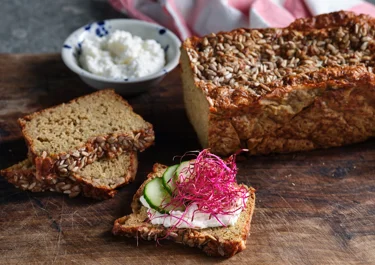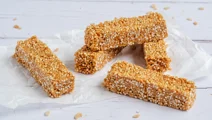High protein bread with cottage cheese

Embark on a bread-making adventure with our high protein loaf – a delicious twist on a classic that’s both flavourful and packed with protein. Infused with the warm, aromatic notes of fennel and cumin and enriched by the creamy smoothness of cottage cheese, this recipe is a true breakfast delight. Turn a simple loaf into a celebration of rich flavours with every bite!
Ingredients
|
3
Eggs
|
|
|---|---|
|
270 g
Oat flour
|
|
|
2 tsp
Bicarbonate of soda
|
|
|
½ tsp
Whole fennel seeds, ground
|
|
|
½ tsp
Whole cumin, ground
|
|
|
½ tsp
Salt
|
|
|
500 g
Cottage cheese
|
Topping
|
60 g
Sunflower seeds
|
|
|---|---|
|
1 tsp
Flake salt
|
Instructions
Recommended information
Serving suggestion
Avoid overmixing for the perfect crumb
Overmixing can develop too much gluten, resulting in a dense, tough loaf rather than the light, tender crumb you want. Mix until the ingredients are just combined, creating a slightly sticky dough that will set perfectly during baking. A gentle hand will help preserve the bread's structure, allowing it to rise beautifully and stay soft inside with a slight crunch on the crust. This technique keeps the bread airy, making each slice deliciously satisfying.
Use room temperature eggs for a smoother dough
For the best possible results, make sure your eggs are at room temperature before adding them to the dough. Cold eggs can make the dough stiff and difficult to mix, which could prevent it from rising evenly. Simply take the eggs out of the refrigerator about 30 minutes before you start baking, or let them sit in a bowl of warm (not hot) water for a few minutes. This small step helps ensure the eggs blend seamlessly with the other ingredients, leading to a smoother, more cohesive dough and ultimately, a more satisfying loaf.
Grind your own spices for enhanced flavour
For the freshest, most vibrant flavour, try grinding your own spices just before adding them to the dough. Whole spices – like fennel seeds or cumin in this recipe – release their essential oils when freshly ground, creating a richer, more aromatic experience than pre-ground spices can offer. A small mortar and pestle or spice grinder works perfectly for this task. This simple step elevates the flavour profile, making every bite uniquely delicious.
FAQ: Questions about high protein bread
To help you get the most out of every loaf, we’ve answered some common questions – from tips on keeping your loaves fresh to creative serving ideas and techniques for perfecting each slice. Dive in and discover how to make every bite of this bread a delight!
What makes this bread high in protein?
This bread’s high protein content mainly comes from a blend of cottage cheese, eggs and seeds. Each of these ingredients contributes to a hearty loaf with a satisfying texture and depth of flavour. The cottage cheese in particular adds richness and a slight tang, while the eggs bind everything together. The sunflower seeds not only add extra protein but also create a delightful crunch and visual appeal.
How do I prevent the toppings from falling off?
To keep your toppings securely in place, brush the dough’s surface with a little water before sprinkling on the sunflower seeds and flake salt. This extra layer of moisture helps the toppings adhere better, while also adding a sheen to the loaf once baked. After sprinkling them on, gently press down with your fingers to ensure they stick more firmly. Avoid adding too much to the loaf’s surface, as overcrowding can make the toppings more likely to fall off.
How do I know my high protein bread is fully baked?
A deep golden-brown crust is a good sign that the bread has baked through. You can also tap the bottom of the loaf (once it's cool enough to handle); if it sounds hollow, it’s likely done. For a more precise test, insert a skewer or toothpick into the centre of the bread. If it comes out clean or with just a few dry crumbs, your bread is fully baked and ready to cool.
Nutritional values
Nutritional value, per
1687 Kcal
| Fibre | 27.1 gram fibers |
| Protein | 98.2 gram |
| Fat | 60.2 gram |
| Carbohydrates | 185.9 gram |
Proper storage for high protein bread
To keep your loaf fresh, wrap it in a clean tea towel once it has fully cooled. This lets the bread breathe, maintaining its crusty exterior without becoming soggy. Place the wrapped loaf in a bread box or airtight container at room temperature, where it will stay fresh for up to two days. This recipe is also suitable for freezing – scroll down for expert tips on longer storage.
Why cottage cheese makes this bread extra special
Cottage cheese is the star ingredient that gives this bread its unique character. When mixed into the dough, it provides a mild tang and a soft, moist crumb, making every slice extra satisfying. Cottage cheese also creates small pockets of creaminess throughout the loaf, adding a delightful texture that contrasts beautifully with the bread’s dense structure.
Unlike other cheeses, cottage cheese blends seamlessly into the dough, imparting richness without overpowering the other flavours. It’s a simple addition that brings balance and depth as well as a protein boost, making this high protein bread truly stand out.
Wondering what to do with leftover cottage cheese? Try making protein French toast for a tasty breakfast with added protein.
Advanced preparation techniques
If you’re aiming to take your bread-baking to the next level, try incorporating a few advanced techniques. Try the autolyse method – allowing the dough to rest after the initial mix – to naturally develop gluten, resulting in a lighter crumb. Pre-soaking the sunflower seeds is another great step; it enhances their flavour and prevents them from drawing moisture out of the dough during baking. These small tweaks can add depth and sophistication to your bread, making each slice more enjoyable.
Freezing for extended freshness
Freezing is a fantastic option for extending the freshness of your high protein bread, especially if you’ve made a large batch. Simply allow the bread to cool completely, then slice and wrap each portion individually in cling film or foil. Place the slices in a freezer-safe bag to protect them from freezer burn, and they’ll keep for several weeks. When you’re ready to enjoy, toast or warm the slices directly from frozen. This method not only saves time but also ensures that you always have a piece of fresh-tasting bread ready for the breakfast table.
Rustic presentation ideas
For a rustic presentation, serve your loaf on a wooden cutting board, adding a few sprigs of fresh herbs on the side for a warm, inviting look. Alternatively, tear or cut the bread into thick, hearty slices and arrange them in a basket lined with a linen cloth for a cozy, farmhouse feel.
Make it part of a larger breakfast spread by pairing it with other protein-rich dishes like savoury protein muffins, creamy high protein scrambled eggs, or a breakfast protein shake featuring skyr, bananas and chocolate milk. Keep in mind that, when serving other dishes with your high protein bread, it may change this recipe’s nutritional values, including the protein content.









